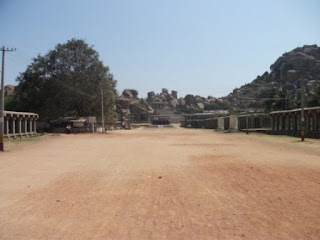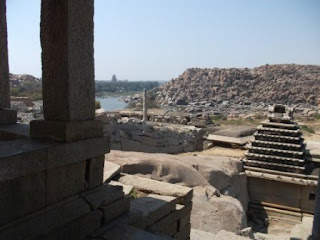I caught up on some sleep after my previous night’s barnyard animal party (hmm, maybe that doesn’t sound quite right) so I got a bit of a late start on the day. I had lunch at a restaurant by the river and as I waited for my meal a young boy came up to me attempting to flog some postcards. I initially declined but then gave him a chance to do his pitch. Hanuman (named after the monkey god I guess) was quite the little salesman. I ended up purchasing 70 rupees worth of cards which made him extremely happy. I hadn’t seen many postcards in shops either so I saved me the hassle of trying to hunt them down. I asked Hanuman whether he was still attending school and was pleased to hear that he was. Today was Saturday so there was no school and after the sale, he ran off to play some cricket with some other boys down by the river...good man, he’s got a balance between education, business and pleasure already at such a young age!
Just one of those great random scenes you see in India:

Me and the budding salesman Hanuman:

I crossed the river in the busy little ferry boat and walked up to the tallest temple, Virupaksha, which stands 50 meters tall and was constructed in 1442 with a nearby smaller, similar temple added in 1510. There was an inner temple courtyard between the two towers that cost a whole 2 rupees to enter (5 cents) and another 50 rupees to take photographs although I don’t know how they kept track of that as my photography ticket was chucked in a bin as soon as I entered.
Virupaksha Temple:

There were many Indian school kids running around in the courtyard and all of them, including me, were first drawn to the elephant that stood off to the left under a covered walkway with his trainer. The temple elephant, Lakshmi, sported some decorative paint on her forehead and after watching for a few minutes I saw how she earned her keep. People would hold out a coin which Lakshmi would grab with her trunk, pass to her keeper, and then swing her trunk back and pat the person, and sometimes others around them, on the head. Not a bad money maker.
Lakshmi earning her keep:

Inside the temple courtyard:

The entrance to the temple:

As I wondered around the temple I was accosted, in a friendly way, by many of the school children. They would ask me where I’m from, what’s my name and would also want to shake my hand. When they saw my camera then it was definitely time for a photo. They would shriek with joy upon seeing the pictures I had just taken of them...it was hard not to love their enthusiasm.
The excited and friendly school kids:

Shiva I believe (still boning up on my Indian gods):

Insert random cow in temple here:

After the temple I began to walk up nearby Hemakuta Hill which has a scattering of early ruins including a monolithic sculpture of Ganesh, the elephant god, which stands 4.5 meters high. The hill itself is like a massive rock face with next to no vegetation on it, just these huge rocks the size of houses and then ancient temples here and there.
Knuffle Bunny is finally back on the road:

Now my turn:

Hemakuta Hill:

Big rocks...you probably can't see it but there's a human right in the middle:

Maybe you can make out the scale on this one:

The monolithic Ganesh (he's the one on the left):

My next and final stop of the day was to hike up a hill near the Achyutaraya Temple (that I visited yesterday). The hill looked about 100-120 meters high and I figured that there would be a great panoramic view from the top. Rock steps wound their way almost to the top and the view was fantastic. I was sitting on a plateau, soaking up the view when I heard the sound of an empty water bottle bouncing off of the rocks above me. As the container reached me I caught it to prevent it from going over the edge. I looked up and it was an older security guard wearing a toque (who needs a toque in this weather?!?) and he said something to the effect of “Don’t worry about it, let it go.” I think he had thrown it down on purpose. It seemed a bit odd to me, aren’t you supposed to be protecting this historic site dude? And here you are littering. I have to admit that the amount of littering that occurs in this country is a bit disturbing...people just don’t seem to care. Granted that there isn’t a very good sanitation infrastructure but still, a little effort could go a long way.
Up on the hill:

Looking down at Achyutaraya Temple:
The security guard walked past me as I put his empty bottle in my backpack. He was walking down a different way than I had come up so I thought I’d head that way too. I then heard someone else coming down from above but in fact it was a large, black faced monkey. He continued down the path so I decided to follow him. The monkey would stop in the middle of the trail when he got within 10 feet of the guard and I would also stop behind the monkey. He would pull branches of certain bushes down to his mouth and gobble up some of the tastier leaves while I tried to snap some pics. We became like a small convoy heading down the hill. The monkey didn’t seem terribly bothered by me and allowed me to get quite close. In a narrow, steeper section, the monkey almost caught up to the guard and I was right behind him. The animal turned back towards me and walked up the steps to me. I just stood there, figuring he would just pass by but as he reached me he turned and put his arms on the sides of my left leg. “Okay buddy, this might be a little friendlier than I wish to get with you!” The guard told me not to give him anything to eat and even if I had any food on me, I wouldn’t have. I backed away a bit and the monkey climbed down a couple of steps...whew, that was close.
Following the monkey and the guard:

A little monkey business:

Even the monkey was enjoying the views:

Another happy day in Hampi.




































